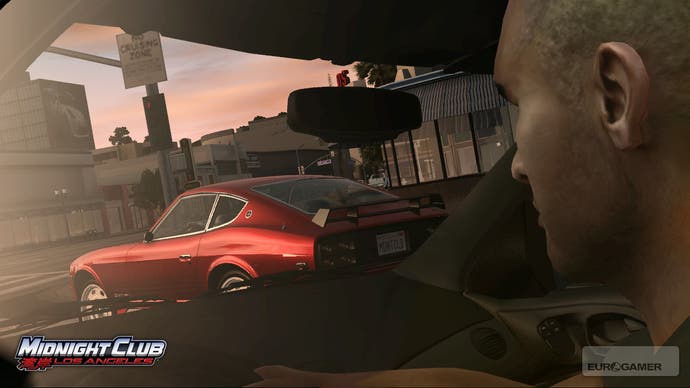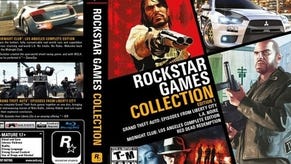Midnight Club: Los Angeles
Poise in the hood.
After besting Liberty City a couple of months ago, we all deserve a nice rest - and where better to head than Los Angeles? Actually we can think of lots of better places to head than Los Angeles - the inside of a woodchipper, for instance - but then Midnight Club's isn't quite the LA we know: it's a curvy cut that runs from Santa Monica to Downtown and takes in Hollywood on the way. A sizeable, varied strip of land where - in the hands of Rockstar San Diego, veterans of three Midnight Club games and a pair of Midtown Madnesses - gridlock is half the fun.
Midnight Club games are about racing through traffic at high speed, using the mini-map to pick your own route between checkpoints, and using a range of powered-up arcade skills like slipstream turbos and in-air weight redistribution to outpace the opposition, most of whom are only too happy to point out you ain't got the skills to be number one fool. Midnight Club 3: DUB Edition, the series' blinged-out third outing, rubbed (or perhaps dubbed) a few people the wrong way with its customisation racket, but the core of the game has always been speed, spills and shortcuts.
So it is with Midnight Club: Los Angeles, which aims to satisfy more gamers more of the time. People who want to reskin and rebuild their Mazda RX8s and Ford GTs can pile on vinyl patterns, wide body kits, mentalist spoilers and performance tweaks, while speed freaks can ignore the doll's-house antics and auto-equip the best kit based on money earned. Casual racers and hardcore nuts (veterans of Midnight Club II perhaps - respect) can pick their races from an assortment of start points laid out on the game's GTA-style GPS and colour-coded for difficulty settings. Xbox Live and PSN devotees can flick a switch to blend their city with their friends for a shared racing playground, show off their custom paintjobs, duel or play chicken with the donut-chomping fuzz. LA's multifaceted core - laid out with a bit of artistic driving licence - is playground enough for all, and unlocked fully from the start.

Visually we're in the same neighbourhood as GTA IV - not surprising, since Rockstar San Diego built the RAGE engine that powered it - with 24-hour lighting that stirs your experience through the multicoloured haze of the California coastline cauldron, dragging the mirror-shade exteriors of hotels and corporate HQs across the gloss-blasted outlines of Saleens and Skylines. People mill in the street (although you won't be running them over out west), lamp-posts, bins, bus-stops and papery rubbish flaps half-heartedly at your speedy progress, and nitrous injection (upgradeable, essential, celebrated with a salutary tilt of the camera) scores your peripheral vision as though your pupils are trying to escape through the back of your head. The frame-rate in our (admittedly debug) code is a bit skittish, but it doesn't interfere.
Reputation points drive your progress, unlocking new cars and the right to buy more luxurious performance and aesthetic upgrades. An experience points system in practice, you build rep whatever you're doing. Caught speeding by the cops? If you can escape you'll earn some rep points (and unlock an Achievement on 360). When you flash your lights at somebody to start a race, you can try and beat them to the starting line for a rep-point bonus (or skip if you prefer). And whether you win or lose the actual contest, you pick up points. As we said in last week's brief first-look at the game, you could conceivably play the first race over and over again to unlock everything. On second thoughts, you could conceivably lose the first race over and over again to unlock everything. We like games that reward endeavour, however feeble.

But we're not here to lose, and so we don't. Taking on a checkpoint race - one of MC's classics, where you pick your own path between checkpoints marked by coloured flares dumped in the street - we start by reaching for the accelerator trigger and clamping down on the handbrake button, which allows us to fire ourselves off the start line at speed. The handling's distinct from GTA IV's: you can throw the back out a bit, but the car generally doesn't spin out unless you smash into traffic or walls; you just lose a bit of speed for going too far sideways.
And your left index finger gets the day off: there's a brake there, but you generally clamp the accelerator down and feather the handbrake if you need a bit more bend into a turn. You build up speed quickly - even in the Mazda, and especially in some of the other vehicles we saw but aren't allowed to talk about - and inclusions like the action cam, which lets you weave a bit on-screen without itself moving, and hero's-favourite the bumper cam, give the traffic-dodging of freeway chases character.



